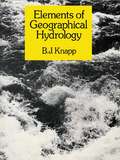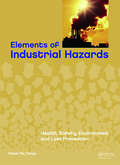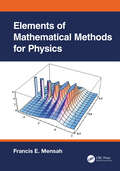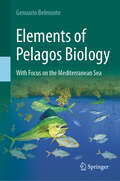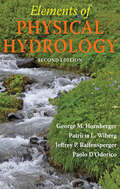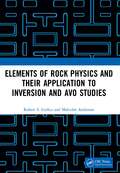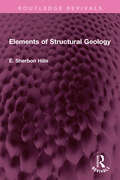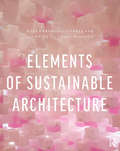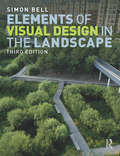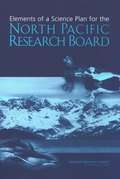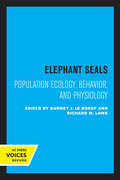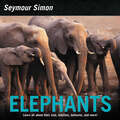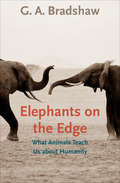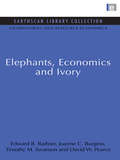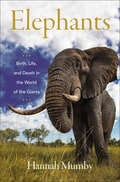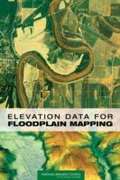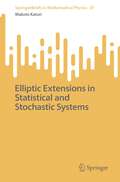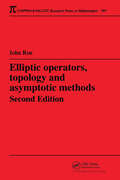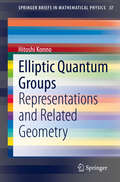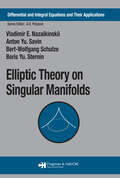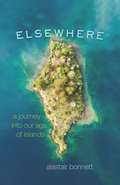- Table View
- List View
Elements of Environmental Management
by Werner AntweilerAs businesses face an increasing array of environmental challenges, including climate change, air and water pollution, and solid waste management, environmental management has become an increasingly important area of expertise. Elements of Environmental Management is an interdisciplinary textbook for students and business professionals that integrates corporate environmental strategy with environmental economics, environmental law, and environmental engineering.Written by Werner Antweiler, an expert on international trade and environmental economics, Elements of Environmental Management approaches environmental issues from a business perspective: How can businesses respond to public policies and regulatory requirements? How does emission trading work? What technological options are available to prevent or mitigate pollution? Using examples from a wide range of industries, Antweiler presents the essential tools for examining environmental problems from a business perspective.
Elements of Geographical Hydrology
by B.J. KnappThis is a concise introduction to principles and applications of hydrology in a geographical context. It uses a wealth of fully illustrated examples to relate theory to the real geographical problems associated with a subject central to our understanding of the natural environment and the use we make of it. Whilst hydrology and the study of water resources have been established for sometime as topics for advanced study, they have been introduced into A-level syllabuses only recently. Elements of Geographical Hydrology is one of the first books aiming to serve the specific requirements at this level. It provides a sound introduction to the theory and principles of hydrology and illustrates them by means of examples. It then proceeds to show the relevance of hydrology to several important aspects of geography, namely: soil studies, hillslope development, and water resource management. It relies throughout on detailed examples, an approach which should enliven the subject and provide substantial material to bring home its realities and reinforce the reader's understanding. The book is fully illustrated with many line drawings and photographs, all of which are closely linked with the text. It offers opportunities for the reader to test his or her understanding of the subject by means of problem exercises. A selected and annotated list of further reading indicates the most useful and accessible sources of more comprehensive and advanced material.
Elements of Industrial Hazards: Health, Safety, Environment and Loss Prevention
by Ratan Raj TatiyaAn introductory course on Health, Safety and Environment (HSE) as applicable to all manufacturing and exploration engineering industries. Its first part deals with fundamentals, ecology and environmental engineering and covers air and water pollution sources, magnitude, measuring techniques and remedial measures to minimize them. The second pa
Elements of Japanese Design
by Boye Lafayette De MenteElements of Japanese Design introduces 80 key concepts in Japanese design in a readable and accessible short-entry format. Including a brief explanation and examples of every aspect of Japanese design-from Wah (Harmony) to Kaizen (Continuous Improvement), from Mushin (the Empty Mind) to Mujo (Incompleteness).
Elements of Mathematical Analysis: An Informal Introduction for Physics and Engineering Students (SpringerBriefs in Physics)
by Costas J. PapachristouThis book provides a comprehensive yet informal introduction to differentiating and integrating real functions with one variable. It also covers basic first-order differential equations and introduces higher-dimensional differentiation and integration. The focus is on significant theoretical proofs, accompanied by illustrative examples for clarity. A comprehensive bibliography aids deeper understanding. The concept of a function's differential is a central theme, relating to the "differential" within integrals. The discussion of indefinite integrals (collections of antiderivatives) precedes definite integrals, naturally connecting the two. The Appendix offers essential math formulas, exercise properties, and an in-depth exploration of continuity and differentiability. Select exercise solutions are provided. This book suits short introductory math courses for novice physics/engineering students. It equips them with vital differential and integral calculus tools for real-world applications. It is also useful for first-year undergraduates, reinforcing advanced calculus foundations for better Physics comprehension.
Elements of Mathematical Methods for Physics
by Francis E. MensahElements of Mathematical Methods for Physics provides students with an approachable and innovative introduction to key concepts of mathematical physics, accompanied by clear and concise explanations, relevant real-world examples and problems that help them to master the fundamentals of mathematical physics. The topics are presented at a basic level, for students lacking a prior mathematical background.This book is designed to be covered in two semesters, presenting 18 chapters on topics varying from differential equations, matrix algebra and tensor analysis to Fourier transform, including special functions and dynamical systems.Upper-level undergraduate and graduate students of physics and engineering as well as professionals will gain a better grip of the basics and a deeper insight into and appreciation for mathematical methods for physics.Key Features:• Reviews and presents the basic math skills needed at the undergraduate level.• Chapters accompanied by examples and end-of-chapter problems to enhance understanding.• Introduces dynamical systems and includes a chapter on Hilbert Space
Elements of Pelagos Biology: With Focus on the Mediterranean Sea
by Genuario BelmonteOceans cover more than 70% of the Earth's surface, with an average depth of approximately 3,800 meters. Humanity is largely excluded from this vast world of saltwater, which remains mostly unexplored and unknown. The goal of this book is to introduce readers to this unfamiliar and mysterious realm. It delves into various species and communities in great detail, emphasizing that the taxonomy, life cycles, and ecological dynamics differ significantly from what is typically taught in basic Biology and Natural Sciences courses, which often focus on terrestrial or freshwater environments, and occasionally, benthic habitats. The pelagic lifestyle, by contrast, is rarely emphasized in Marine Biology textbooks. This book aims to shift that perspective, highlighting the pelagic way of life for marine organisms. As a teaching method, species, geographical locations, and key topics are repeatedly revisited throughout the text to enhance their visibility and reinforce their understanding in the minds of students.
Elements of Physical Hydrology
by George M. Hornberger Patricia L. Wiberg Jeffrey P. Raffensperger Paolo D'OdoricoThe most cogent textbook ever produced on the topic, this revised and expanded edition will be welcomed by students and professionals alike.Among the many diverse aspects of environmental science, none is more critical to the future of society and nature than water. Understanding the role of water on Earth and making good decisions regarding water conservation and hydrological hazards depends on learning the fundamentals of physical hydrology. This textbook, now in an expanded second edition, provides the clearest opportunity for students to absorb those fundamentals. Written at an introductory level, Elements of Physical Hydrology covers virtually every aspect of this subject, including:• The hydrological cycle• Water budgets at catchment to global scales • Spatial and temporal aspects of precipitation• Evapotranspiration• Fluid dynamics and the Bernoulli equation• Laminar and turbulent flows• Open channel flow • Flood movement through reservoirs and channels • Flood frequency analysis• Groundwater flow• Aquifer characterization• Land subsidence• Soil moisture dynamics• Flow in the unsaturated zone• Hydrologic controls on vegetation • Biotic controls on hydrological processes• Runoff generation from surface and subsurface sources• Catchment models• The water-food-energy nexus• The globalization of water• Impacts of changing climateLayering one topic upon the next, Elements of Physical Hydrology succeeds in moving from simple, easy-to-grasp explanations through equations and models in a manner that will leave students new to the topic eager to apply their knowledge. Professionals in related disciplines will also find this book ideal for self-study. Thoughtfully illustrated, carefully written, and covering a broad spectrum of topics, this classic text clarifies a subject that is often misunderstood and oversimplified.
Elements of Rock Physics and Their Application to Inversion and AVO Studies
by Malcolm Anderson Robert S. GullcoThe ultimate aim of the oil exploration industry is to determine the distribution of rock types and underground fluids. At this stage, we can actually determine the distribution of several underground physical properties with a certain accuracy. The challenge for the rock physicist is to translate those physical properties (P-velocity, S-velocity, density) into rock types and fluids (gas-, or oil-, or water-bearing sand, shale). If performed correctly, dry holes can be avoided and millions of dollars can be saved. Ultimately, an integrated approach is required. This book deals with a series of topics in rock physics, including elasticity, pore pressure, incompressibility of rocks and the Gassmann equation, fluid substitution, forward modelling and empirical equations, rock physics applications to AVO studies and inversion studies, and the Differential Effective Medium (DEM) method. It is generally addressed to the practitioner (geophysicist, geologist), and in some instances, detailed instructions are furnished to perform a particular task. Some chapters, on the other hand, are theoretical and more mathematical, and are expected to be of interest to both practitioners and students alike. Other chapters include innovative ideas that could, for instance, be tested by oil companies that have substantial amounts of data at their disposal. This book will serve as a useful guide to practitioners (geologists, petrophysicists, geophysicists and reservoir engineers) and students/academics.
Elements of Structural Geology (Routledge Revivals)
by E. Sherbon HillsOriginally published in 1963, this classic textbook was revised fully for the 1972 edition. The author presents a comprehensive account of all topics falling within the domain of structural geology in his characteristically objective, scientific and logical manner. The book pays particular attention to definitions and the origin of terms. Geology is a global science and this book used examples and ideas from work in many countries. The book is comprehensive in scope, dealing not only with secondary structures and tectonics, but also with primary structures of secondary and igneous rocks. This was the first textbook to deal with rock material as two-phase systems rather than as solids and this approach is continued in this reissued edition by analysis of concepts such as ocean-floor spreading and plate tectonics
Elements of Sustainable Architecture
by Rosa Urbano Gutiérrez Laura de la Plaza HidalgoFor sustainable architecture to become a reality, the way we design buildings needs to change. Many architects are concerned that sustainable technologies may interfere with a building’s aesthetic appearance, and so these are often ‘added on’ once the design process is complete. Elements of Sustainable Architecture solves this dilemma by helping students to develop the design skills they need to create sustainable buildings – ensuring that ecological considerations are applied throughout the design process. Restoring the primacy of aesthetics and creativity to sustainable design, the book focuses on strategies that have the greatest impact on building design. It also shows the influence of sustainability considerations on choices about aspects such as composition, form, space, tectonics, materials, colour, textures, proportion and position. Specifically designed to offer a new way of understanding architecture, the book: introduces students to the basic principles and methods of sustainable design; features current examples and inspiring case studies to support learning step by step; presents information in a visually appealing, intuitive, easy-to-understand way; includes over 500 high-quality colour diagrams, drawings, sketches and photographs. A clear, visual introduction to creating aesthetically beautiful and sustainable buildings, this is essential reading for students in sustainable architecture courses.
Elements of Visual Design in the Landscape
by Simon BellWhat makes a visually appealing landscape? How can the design and use of a landscape be harmonized? In this significantly revised and updated third edition of Simon Bell's seminal text, he further explores the answers to these questions by interrogating a range of design principles, applications and ideas. Written for students, instructors and professionals, the book unveils a visual design vocabulary for anyone involved with landscape aesthetics including landscape architects, architects, planners, urban designers, landscape managers, foresters, geographers and ecologists. Structured around key design terms, which are explained and illustrated using an extensive range of examples from around the world, including North America, Europe and Asia, this book enables you to describe, debate and design the visual landscape. It starts with basic elements, before moving onto variable design components, and then the ways these elements are organized into compositions, in order to demonstrate how landscapes are created and how meanings and patterns are perceived within them. This new full colour edition contains over 240 images; an updated introduction; examples from China, Vietnam and central Asia; a chapter on how to read and understand visual design elements in the landscape; a teaching model for instructors; and expanded appendix materials including a glossary, references and further reading.
Elements of a Science Plan for the North Pacific Research Board
by Committee on a Science Plan for the North Pacific Research BoardThe North Pacific Research Board (NPRB) was established in 1997 as custodian to a pool of funds intended for the study of the North Pacific Ocean, Bering Sea, and Arctic Ocean. The success of the NRPB is the development of a high quality, long-range science plan that provides a better understanding of ecosystems and their fisheries in the region. This report provides a framework to help the NPRB identify appropriate science themes and mechanisms for administering and distributing the funds. It contains extensive input from residents of Alaskan communities, to help scientists understand and address issues of importance to the local communities. The book makes specific recommendations on long-term research priorities, the NPRB management structure and the development of future programs.
Elephant Seals: Population Ecology, Behavior, and Physiology
by Burney J. Le Boeuf Richard M. LawsThe largest of all seals, elephant seals rank among the most impressive of marine mammals. They are renowned for their spectacular recovery from near-extinction at the end of the nineteenth century when seal hunters nearly eliminated the entire northern species. No other vertebrate has come so close to extinction and made such a complete recovery. The physiological extremes that elephant seals can tolerate are also remarkable: females fast for a month while lactating, and the largest breeding males fast for over one hundred days during the breeding seasons, at which times both sexes lose forty percent of their body weight. Elephant seals dive constantly during their long foraging migrations, spending more time under water than most whales and diving deeper and longer than any other marine mammal. This first book-length discussion of elephant seals brings together worldwide expertise from scientists who describe and debate recent research, including the history and status of various populations, their life-history tactics, and other findings obtained with the help of modern microcomputer diving instruments attached to free-ranging seals. Essential for all marine mammalogists for its information and its methodological innovations, Elephant Seals will also illuminate current debates about species extinctions and possible means of preventing them. This title is part of UC Press's Voices Revived program, which commemorates University of California Press’s mission to seek out and cultivate the brightest minds and give them voice, reach, and impact. Drawing on a backlist dating to 1893, Voices Revived makes high-quality, peer-reviewed scholarship accessible once again using print-on-demand technology. This title was originally published in 1994.
Elephants
by Seymour SimonJoin award-winning science writer Seymour Simon as he investigates the many characteristics and behaviors of one of the world’s most beloved animals: the elephant! This nonfiction picture book is an excellent choice to share during homeschooling, in particular for children ages 6 to 8. It’s a fun way to learn to read and as a supplement for activity books for children.From their ancient relatives, woolly mammoths and mastodons, to their amazingly versatile trunks and strong ivory tusks, elephants are some of the most fascinating animals on Earth. They are remarkably intelligent, demonstrate self-awareness, and feel familiar emotions like compassion and grief.With clear, simple text and stunning full-color photographs, readers will learn all about the largest land animals in the world!Perfect for young scientists’ school reports, this book includes an author's note, a glossary, and an index and supports the Common Core State Standards.
Elephants on the Edge: What Animals Teach Us about Humanity
by G. A. Bradshaw&“At times sad and at times heartwarming . . . Helps us to understand not only elephants, but all animals, including ourselves&” (Peter Singer, author of Animal Liberation). Drawing on accounts from India to Africa and California to Tennessee, and on research in neuroscience, psychology, and animal behavior, G. A. Bradshaw explores the minds, emotions, and lives of elephants. Wars, starvation, mass culls, poaching, and habitat loss have reduced elephant numbers from more than ten million to a few hundred thousand, leaving orphans bereft of the elders who would normally mentor them. As a consequence, traumatized elephants have become aggressive against people, other animals, and even one another; their behavior is comparable to that of humans who have experienced genocide, other types of violence, and social collapse. By exploring the elephant mind and experience in the wild and in captivity, Bradshaw bears witness to the breakdown of ancient elephant cultures. But, she reminds us, all is not lost. People are working to save elephants by rescuing orphaned infants and rehabilitating adult zoo and circus elephants, using the same principles psychologists apply in treating humans who have survived trauma. Bradshaw urges us to support these and other models of elephant recovery and to solve pressing social and environmental crises affecting all animals—humans included. &“This book opens the door into the soul of the elephant. It will really make you think about our relationship with other animals.&” —Temple Grandin, author of Animals in Translation
Elephants, Economics and Ivory: Elephants, Economics And Ivory (Environmental and Resource Economics Set)
by Edward B. Barbier Joanne C. Burgess Timothy M. Swanson David W. PearceIvory is big business, and in some parts of Africa elephants have been hunted almost to extinction in the quest for it. The losses to African economies have been catastrophic. Now there is an international ban on the trade and conservation is. the principal goal. This should be a matter for rejoicing, but nothing is quite so simple. The authors of this book have looked at the overall statistics, including those for countries where the elephant population is stable. They have considered the multiplicity of economic and social functions fulfilled by ensuring that elephant herds survive, tourism, a variety of ecological purpose. and, finally, as a source of ivory. They show how the careful management of elephants as a resource can best serve African interests. This book is at the cutting edge of economic thinking and provides a model for the consideration of the difficult relationship between people and wildlife. Originally published in 19990
Elephants: Birth, Life, and Death in the World of the Giants
by Hannah Mumby“Walking with these elephants, and with Hannah, will appeal to the Planet Earth viewer and the Robert Macfarlane reader in equal measure.” —Dan Jones, New York Times–bestselling authorWhat Jane Goodall did for chimpanzees, international ecologist and conservation scientist Hannah Mumby now does for elephants in this compelling, eye-opening account that brings into focus this species remarkably similar to humans—and makes a persuasive argument for saving them.These extraordinary animals have so much to teach us, Mumby argues, and Elephants takes readers into their world as never before, revealing a society as complex as the chimpanzees, maybe even humans. Mumby’s exploration of elephant culture provides an empathetic, humanistic portrait of these majestic animals, illuminating their personalities, memories, and rich emotional lives. Mumby explains how elephants communicate with one another and demonstrates the connection between memory and trauma—how it affects individual elephants and their interactions with others in their herd. Elephants and humans, Mumby makes clear, are not very different. From emotional bonding to communication, human and elephant experience similarly nuanced lives, and the commonalities she uncovers are both surprising and heartwarming.Featuring a sixteen-page color insert of original photography, Elephants is a captivating, deeply moving exploration that offers a new way to look at these pachyderms and ourselves and a persuasive, passionate argument for rethinking our approach to animals and their conservation.
Elevation Data For Floodplain Mapping
by National Research Council of the National AcademiesFloodplain maps serve as the basis for determining whether homes or buildings require flood insurance under the National Flood Insurance Program run by the Federal Emergency Management Agency (FEMA). Approximately $650 billion in insured assets are now covered under the program. FEMA is modernizing floodplain maps to better serve the program. However, concerns have been raised as to the adequacy of the “base map” information available to support floodplain map modernization. Elevation Data for Floodplain Mapping shows that there is sufficient two-dimensional “base map imagery” to meet FEMA’s flood map modernization goals, but that the three-dimensional “base elevation data” that are needed to determine whether a building should have flood insurance are not adequate. This book makes recommendations for a new national digital elevation data collection program to redress the inadequacy. Policy makers, property insurance professionals; federal, local, and state governments; and others concerned with natural disaster prevention and preparedness will find this book of interest.
Elite Women and the Agricultural Landscape, 1700–1830 (Studies in Historical Geography)
by Briony McDonaghElite Women and the Agricultural Landscape, 1700–1830 offers a detailed study of elite women’s relationships with landed property, specifically as they were mediated through the lens of their estate management and improvement. This highly original book provides an explicitly feminist historical geography of the eighteenth-century English rural landscape. It addresses important questions about propertied women’s role in English rural communities and in Georgian society more generally, whilst contributing to wider cultural debates about women’s place in the environmental, social and economic history of Britain. It will be of interest to those working in Historical and Cultural Geography, Social, Economic and Cultural History, Women’s Studies, Gender Studies and Landscape Studies. Chapters 2, 3, and 4 of this book are freely available as downloadable Open Access PDFs at http://www.taylorfrancis.com under a Creative Commons Attribution-Non Commercial-No Derivatives (CC-BY-NC-ND) 4.0 license.
Elliptic Extensions in Statistical and Stochastic Systems (SpringerBriefs in Mathematical Physics #47)
by Makoto KatoriHermite's theorem makes it known that there are three levels of mathematical frames in which a simple addition formula is valid. They are rational, q-analogue, and elliptic-analogue. Based on the addition formula and associated mathematical structures, productive studies have been carried out in the process of q-extension of the rational (classical) formulas in enumerative combinatorics, theory of special functions, representation theory, study of integrable systems, and so on. Originating from the paper by Date, Jimbo, Kuniba, Miwa, and Okado on the exactly solvable statistical mechanics models using the theta function identities (1987), the formulas obtained at the q-level are now extended to the elliptic level in many research fields in mathematics and theoretical physics. In the present monograph, the recent progress of the elliptic extensions in the study of statistical and stochastic models in equilibrium and nonequilibrium statistical mechanics and probability theory is shown. At the elliptic level, many special functions are used, including Jacobi's theta functions, Weierstrass elliptic functions, Jacobi's elliptic functions, and others. This monograph is not intended to be a handbook of mathematical formulas of these elliptic functions, however. Thus, use is made only of the theta function of a complex-valued argument and a real-valued nome, which is a simplified version of the four kinds of Jacobi's theta functions. Then, the seven systems of orthogonal theta functions, written using a polynomial of the argument multiplied by a single theta function, or pairs of such functions, can be defined. They were introduced by Rosengren and Schlosser (2006), in association with the seven irreducible reduced affine root systems. Using Rosengren and Schlosser's theta functions, non-colliding Brownian bridges on a one-dimensional torus and an interval are discussed, along with determinantal point processes on a two-dimensional torus. Their scaling limits are argued, and the infinite particle systems are derived. Such limit transitions will be regarded as the mathematical realizations of the thermodynamic or hydrodynamic limits that are central subjects of statistical mechanics.
Elliptic Operators, Topology, and Asymptotic Methods (Chapman & Hall/CRC Research Notes in Mathematics Series)
by John RoeTen years after publication of the popular first edition of this volume, the index theorem continues to stand as a central result of modern mathematics-one of the most important foci for the interaction of topology, geometry, and analysis. Retaining its concise presentation but offering streamlined analyses and expanded coverage of important exampl
Elliptic Quantum Groups: Representations and Related Geometry (SpringerBriefs in Mathematical Physics #37)
by Hitoshi KonnoThis is the first book on elliptic quantum groups, i.e., quantum groups associated to elliptic solutions of the Yang-Baxter equation. Based on research by the author and his collaborators, the book presents a comprehensive survey on the subject including a brief history of formulations and applications, a detailed formulation of the elliptic quantum group in the Drinfeld realization, explicit construction of both finite and infinite-dimensional representations, and a construction of the vertex operators as intertwining operators of these representations. The vertex operators are important objects in representation theory of quantum groups. In this book, they are used to derive the elliptic q-KZ equations and their elliptic hypergeometric integral solutions. In particular, the so-called elliptic weight functions appear in such solutions. The author’s recent study showed that these elliptic weight functions are identified with Okounkov’s elliptic stable envelopes for certain equivariant elliptic cohomology and play an important role to construct geometric representations of elliptic quantum groups. Okounkov’s geometric approach to quantum integrable systems is a rapidly growing topic in mathematical physics related to the Bethe ansatz, the Alday-Gaiotto-Tachikawa correspondence between 4D SUSY gauge theories and the CFT’s, and the Nekrasov-Shatashvili correspondences between quantum integrable systems and quantum cohomology. To invite the reader to such topics is one of the aims of this book.
Elliptic Theory on Singular Manifolds (Differential and Integral Equations and Their Applications)
by Vladimir E. Nazaikinskii Anton Yu. Savin Bert-Wolfgang Schulze Boris Yu. SterninThe analysis and topology of elliptic operators on manifolds with singularities are much more complicated than in the smooth case and require completely new mathematical notions and theories. While there has recently been much progress in the field, many of these results have remained scattered in journals and preprints.Starting from an ele
Elsewhere: A Journey into Our Age of Islands
by Alastair BonnettThere are millions of islands on our planet. New islands are being built at an unprecedented rate, for tourism and territorial ambition. Many are also disappearing, besieged by rising sea levels. The story of our world’s islands is one of the great dramas of our time, and it is playing out around the planet—islands are sprouting or being submerged everywhere from the South China Sea to the Atlantic. Elsewhere is the story of this strange and mesmerizing planetary spectacle. In this book, explorer and geographer Alastair Bonnett takes us on a thought-provoking tour of the world’s most fascinating islands. He traveled the globe to provide a firsthand look at numerous islands, sketching a vivid likeness of each one he visited. From a “crannog,” an ancient artificial island in a Scottish loch, to the militarized artificial islands China is building; from the disappearing islands that remain the home of native Central Americans to the ritzy new islands of Dubai; from Hong Kong to the Isles of Scilly—all have compelling stories to tell. As we journey around the world with Bonnett, he addresses urgent contemporary issues such as climate change, economic inequality and the changing balance of world power as reflected in the fates of islands. Along the way, we also learn about the many ways islands rise and fall, the long and little-known history of human island building and the prospect that the inland hills and valleys will one day be archipelagos. Featuring Bonnett’s charming hand-drawn maps and 33 full-color photos, Elsewhere is a captivating travel book for any armchair adventurer.

